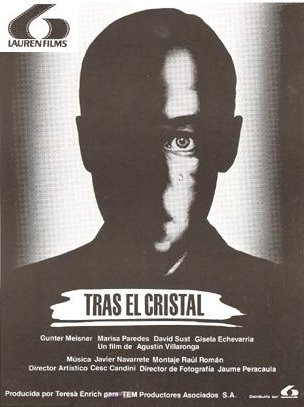 This 1986 Spanish shocker is one of the most repellant, upsetting and relentless movies of all time, but it’s also a superbly made, endlessly thought provoking dissertation on the persistence of evil. Obviously this is not a film for the faint of heart…but then again, I’m honestly not sure who it is for. As the John Waters quote on the DVD cover proclaims: “IN A GLASS CAGE is a great film, but I’m too scared to show it to my friends.”
This 1986 Spanish shocker is one of the most repellant, upsetting and relentless movies of all time, but it’s also a superbly made, endlessly thought provoking dissertation on the persistence of evil. Obviously this is not a film for the faint of heart…but then again, I’m honestly not sure who it is for. As the John Waters quote on the DVD cover proclaims: “IN A GLASS CAGE is a great film, but I’m too scared to show it to my friends.”
I’ll always remember my initial viewing of this film during its brief LA-area theatrical run, when the guy selling tickets actually tried to convince me not to see it(!), warning of “the disturbing nature of this film” with its “scenes of violence against children.” After a send-off like that I simply had to view the film, which, as promised, was extremely disturbing stuff that didn’t go easy on its underage performers.
The writer and director of this sickie was Agusti Villaronga, an extremely intelligent, talented man who went on to make a number of impressive features. None of the subsequent Villaronga films that I’ve seen have the mind shattering power of IN A GLASS CAGE (TRAS EL CRISTAL), although the mystical thriller MOONCHILD (EL NINO DE LA LUNA; 1989) and the supernatural mystery 99.9 (1997) do come close.
In the depths of an abandoned castle, an old man stands before the hideously brutalized body of a young boy. Viewed through an outside window by an unseen voyeur, the man kills the boy with a blow to the head and then, overcome with remorse, runs to the top of the castle and throws himself off.
The story picks up several months later, with the old man now confined to an iron lung (the “glass cage” of the title). He’s watched over by his resentful wife and precocious young daughter, neither of whom is particularly happy with the job. Enter Angelo, a creepy young man who shows up one day offering his services as a nurse. Angelo clearly has some sort of bond with Klaus, the crippled old man, which gradually comes clear: Klaus is an ex-Nazi who secretly got off on abusing children and Angelo one of his (now grown) victims.
Angelo somehow manages to get hold of Klaus’ diaries, which contain a wealth of incriminating information; Angelo, who’s even more deranged than Klaus, uses the diaries to blackmail their author into letting him stay around to carry out his increasingly sick fantasies…which include murdering Klaus’ wife and outfitting his home like a Nazi concentration camp. The worst is yet to come, however: Angelo lures two young boys back to the house and, following descriptions in Klaus’ diaries, brutally kills them in plain view of the latter’s horrified eyes. Angelo then puts his crippled mentor out of his misery, but one factor still remains: Klaus’ daughter, distinctly aware of what’s been going on in the house and finding it all quite intriguing…
As unforgiving as this film is, it’s not particularly graphic. Villaronga’s surprising restraint in depicting violence (nearly all of which occurs offscreen) works quite well in counterpointing his near-unimaginably ugly story, which somehow always manages to top itself in depravity. It contains a succession of wildly nasty bits, each more appalling than the last: Klaus kissing a brutalized child on the mouth in the vile opening sequence; Angelo masturbating into his crippled mentor’s face while reciting a particularly sordid diary entry; a boy convulsing madly after being injected with a lethal dose of poison; and the final freeze frame, depicting the protagonist’s daughter and Angelo engaged in a sordid danse macabre.
This is a DARK film both thematically and visually: Villaronga shot on color film stock, but banished nearly all “color” from his palette (the only shade of red I noticed was a climactic splash of blood) and in addition set his exposures to emit the bare minimum of light required. Also on display are some truly bizarre “love” scenes (in which Angelo removes Klaus’ “glass cage” and presses down on the latter’s chest, acting as his lungs) and an ingenious Alfred Hitchcock inspired sequence depicting Angelo’s protracted stalking and murder of Klaus’ wife.
The result of all this is a palpable sense of pure evil, in this film a tangible force as virulent and seductive as a vampire might be in a conventional horror movie. Like a disease, evil here travels from one generation to the next. For the way it illuminates such difficult concepts and its undeniable technical virtuosity I deeply admire this film, even if I can’t quite bring myself to recommend it.
Vital Statistics
IN A GLASS CAGE [TRAS EL CRISTAL]
Filmax/Cult Epics
Director: Agusti Villaronga
Producer: Teresa Enrich
Screenplay: Agusti Villaronga
Cinematography: Jaume Peracaula
Editor: Paul Roman
Cast: Gunter Meisner, David Sust, Marisa Paredes, Gisela Echevarria, Imma Colomer, Josue Guasch, Alberto Manzano, Ricart Carcelero, David Cuspinera
